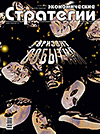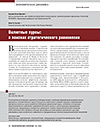Exchange Rates: in Search of Strategic Equilibrium
Keywords:
,
,
,
,
,
As a result of further theoretical development of approaches to modeling equilibrium exchange rates developed a generalized dynamic model based on the concepts of macroeconomic equilibrium and the balance of payments with regard to the mechanism of formation relative international competitive advantage. In the framework proposed by the author concept IFEER withdrawn the final formula of the equilibrium exchange rates depending on the fundamental macroeconomic indicators.
References:
- Engel C.M., Mark N.C., West K.D. Exchange Rate Models Are Not As Bad As You Think / NBER Macroeconomics Annual. Vol. 22. 2007, revised in 2011.
- Dmitrieva M.V., Suetin S.N. Modelirovanie dinamiki ravnovesnykh valyutnykh kursov [Modeling the Dynamics of Equilibrium Exchange Rates]. Vestnik KIGIT, 2012, no 12-2 (30), pp. 061–064.
- Linkevich E.F. Mirovaya valyutnaya sistema: poliinstrumental’nyy standart [The World Monetary System: Poliinstrumental Standard]. Krasnodar, 2014.
- Ageev A.I., Loginov E.L. Izmenenie strategii operirovaniya dollarom: zapusk SShA novogo kreditno-investitsionnogo tsikla vo vzaimosvyazi s valyutnymi voynami [Changing the Strategy of Dollar Handling: US Launch of New Credit-Investment Cycle in Association with the Currency Wars]. Ekonomicheskie strategii, 2015, no 3, pp. 20–35.
- Kuz’min A.Yu. Ekonomiko-matematicheskoe modelirovanie kursa rublya v usloviyakh chlenstva Rossii v VTO [Economic-Mathematical Modeling of the Ruble in Terms of Russia’s Membership in WTO]. Den’gi i kredit, 2014, no 5, pp. 45–49.
- Williamson J. Estimates of FEERs / In Williamson J. (ed.) Estimating Equilibrium Exchange Rates. Washington: Institute for International Economics, 1994.
- Clark P.B., MacDonald R. Exchange Rates and Economic Fundamentals: A Methodological Comparison of BEERs and FEERs / IMF Working Paper 98/67 — Washington: International Monetary Fund, March, 1998.
- Kuz’min A.Yu. Dinamika kursa rublya: faktory i sledstviya [The Dynamics of the Ruble: Factors and Effects]. Ekonomicheskiy analiz: teoriya i praktika, 2011, no 12 (219), pp. 61–68.
- Kuz’min A.Yu. Ravnovesie kursa rublya i problemy optimum [Equilibrium Exchange Rate of the Ruble and the Problems of Optimum]. Ekonomicheskie strategii, 2011, no 2, pp. 104–109.
- Berka M., Devereux M.B., Engel C.M. Real Exchange Rate Adjustment in and out of the Eurozone. American Economic Review — AER, vol. 102, no 3. 2012, pp. 179–185.
- Fedorova E.A., Lazarev M.P. Vliyanie tseny na neft’ na finansovyy rynok Rossii v krizisnyy period [The Impact of Oil Prices on the Financial Market of Russia in the Crisis Period]. Finansy i kredit, 2014, no 20 (596), pp. 14–22.
- Kuzmin A. Exchange Rate Modeling: The Case of Ruble. Review of Business and Economics Studies, vol. 3, no 3, 2015, pр. 39–48.
- MacDonald R., Taylor M.P. The Monetary Model of Exchange Rate: long-run relationship, short-run dynamics and how to beat a Random Walk. Journal of International Money and Finance, no 13, 1994, pр. 276–290.
- Chen J., Mark N.C. Alternative Long-Horizon Exchange-Rate Predictors. International Journal of Finance and Economics, vol. 1, 1996, pp. 229–250.
- Kim B., Mo S. Cointegration and the long-run forecasts of Exchange Rate. Economic Letters, no 48, 1995, pp. 353–359.
- Dropsy V. Macroeconomics Determinants of Exchange Rate: A Frequency-Specific Analysis. Applied Economics (London), no 1, vol. 28, 1996, pp. 55–63.
- Clarida R.H., Sarno L., Taylor M.P., Valente G. The Out-of Sample Success of Term Structure Models as Exchange Rate Predictors: A Step Beyond. NBER Working Paper, no 8601, 2001 (Cambridge, Massachusetts: National Bureau of Economic Research).
- Cheung Y.-W., Chinn M., Pascual A.G. Empirical Exchange Rate models: Are any Fit to Survive? IMF Working Paper WP/04/73, 2004. Washington: IMF.
- Chowdhury I. Sources of Exchange Rate fluctuation: empirical evidence from six emerging market countries. Applied Financial Economics, vol. 14, no 1, 2004, pp. 697–705.
- Kempa B. How important are nominal shocks in driving real exchange rate? Jahrb cher Fur National konomie und Statistic, Stuttgart, Bd. 225, H.2, 2005, pp. 192–204.
- Taylor L. Exchange rate indeterminacy in portfolio balance, Mundell–Fleming and uncovered interest rate parity models. Cambridge Journal of Economics, 28 (2), March, 2004, pp. 205–227.



